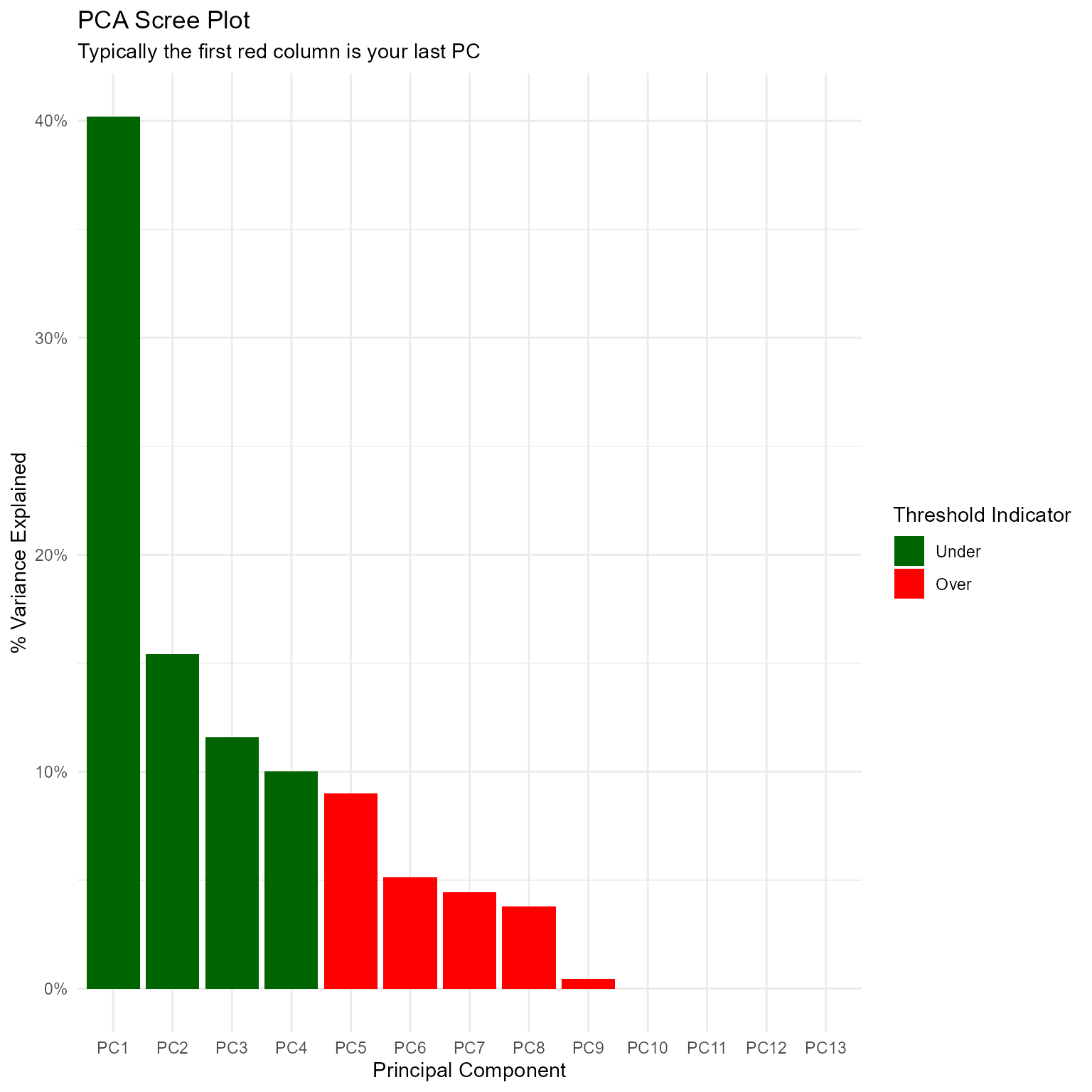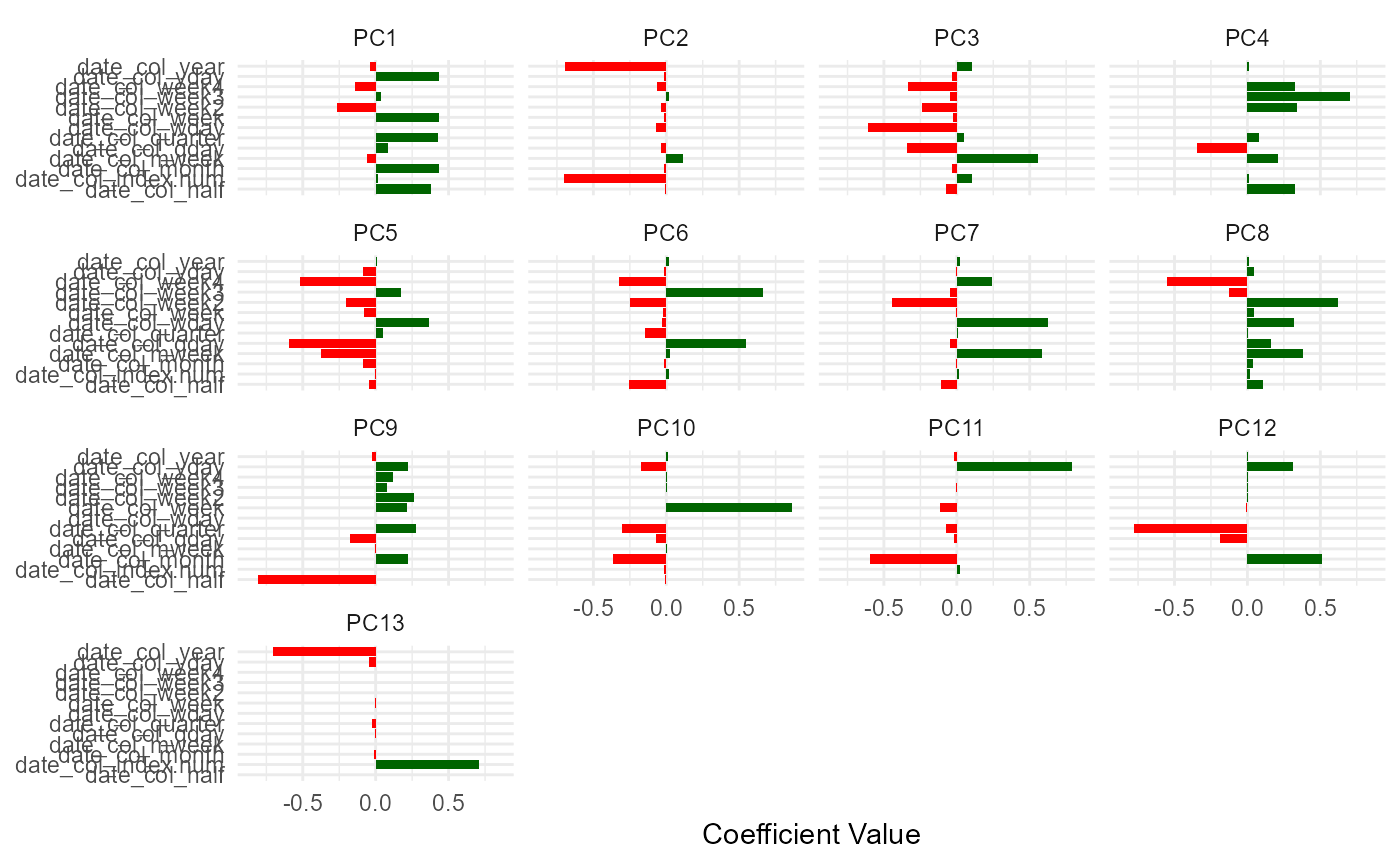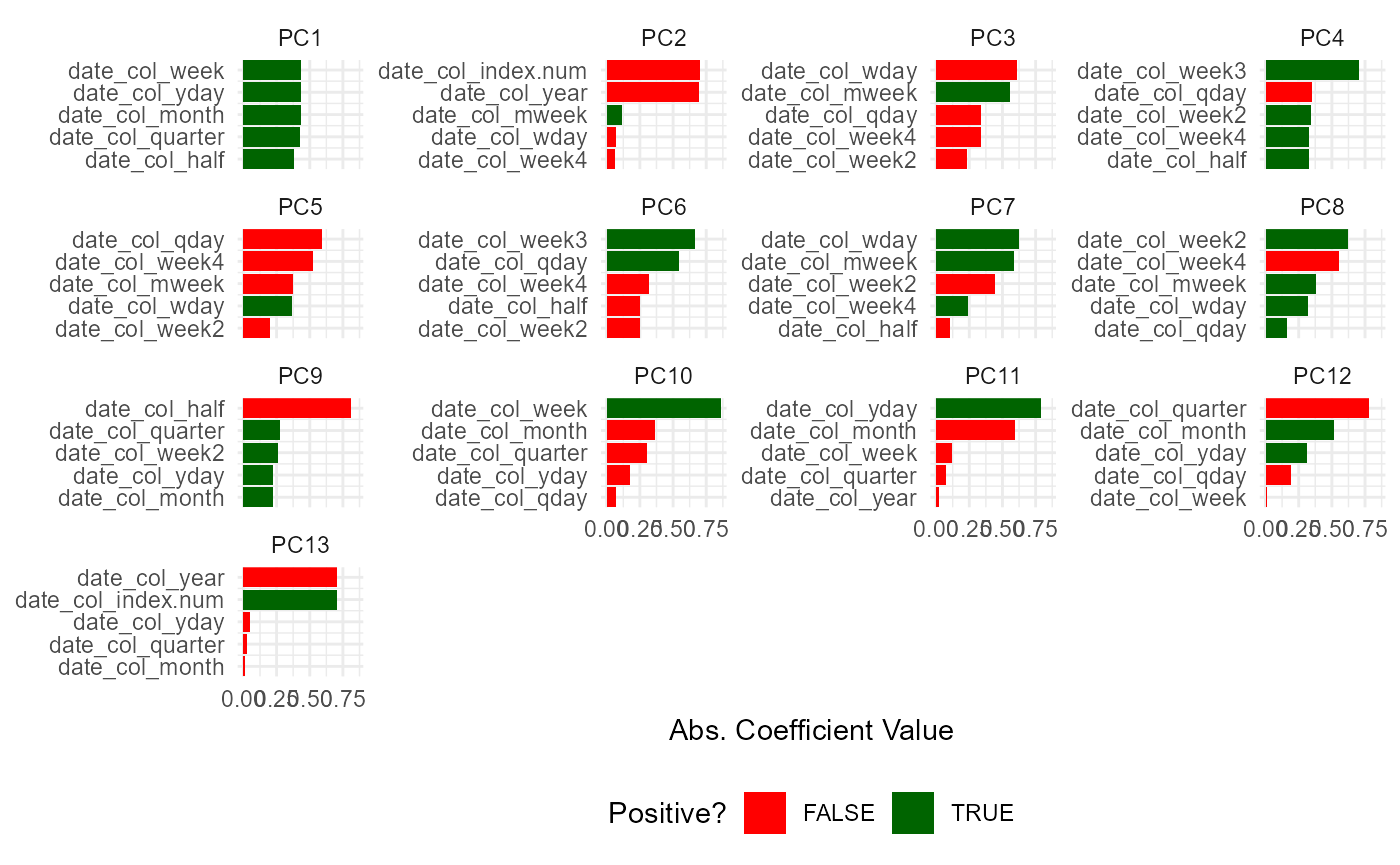
Getting Started with healthyR.ai
A Quick Introduction
Steven P. Sanderson II, MPH
2025-11-06
Source:vignettes/getting-started.Rmd
getting-started.RmdFirst of all, thank you for using healthyR.ai. If you
encounter issues or want to make a feature request, please visit https://github.com/spsanderson/healthyR.ai/issues
library(healthyR.ai)
#>
#> == Welcome to healthyR.ai ===========================================================================
#> If you find this package useful, please leave a star:
#> https://github.com/spsanderson/healthyR.ai'
#>
#> If you encounter a bug or want to request an enhancement please file an issue at:
#> https://github.com/spsanderson/healthyR.ai/issues
#>
#> Thank you for using healthyR.aiIn this should example we will showcase the
pca_your_recipe() function. This function takes only a few
arguments. The arguments are currently .data which is the
full data set that gets passed internally to the
recipes::bake() function, .recipe_object which
is a recipe you have already made and want to pass to the function in
order to perform the pca, and finally .threshold which is
the fraction of the variance that should be captured by the
components.
To start this walk through we will first load in a few libraries.
Data
Now that we have out libraries we can go ahead and get our data set ready.
Data Set
data_tbl <- healthyR_data %>%
select(visit_end_date_time) %>%
summarise_by_time(
.date_var = visit_end_date_time,
.by = "month",
value = n()
) %>%
set_names("date_col","value") %>%
filter_by_time(
.date_var = date_col,
.start_date = "2013",
.end_date = "2020"
) %>%
mutate(date_col = as.Date(date_col))
head(data_tbl)
#> # A tibble: 6 × 2
#> date_col value
#> <date> <int>
#> 1 2013-01-01 2082
#> 2 2013-02-01 1719
#> 3 2013-03-01 1796
#> 4 2013-04-01 1865
#> 5 2013-05-01 2028
#> 6 2013-06-01 1813The data set is simple and by itself would not be at all useful for a
pca analysis since there is only one predictor, being time. In order to
facilitate the use of the function and this example, we will create a
splits object and a recipe object.
Splits
splits <- initial_split(data = data_tbl, prop = 0.8)
splits
#> <Training/Testing/Total>
#> <76/19/95>
head(training(splits))
#> # A tibble: 6 × 2
#> date_col value
#> <date> <int>
#> 1 2016-09-01 1511
#> 2 2014-11-01 1464
#> 3 2019-04-01 1443
#> 4 2018-03-01 1618
#> 5 2016-11-01 1513
#> 6 2015-07-01 1751Initial Recipe
rec_obj <- recipe(value ~ ., training(splits)) %>%
step_timeseries_signature(date_col) %>%
step_rm(matches("(iso$)|(xts$)|(hour)|(min)|(sec)|(am.pm)"))
rec_obj
#>
#> ── Recipe ──────────────────────────────────────────────────────────────────────
#>
#> ── Inputs
#> Number of variables by role
#> outcome: 1
#> predictor: 1
#>
#> ── Operations
#> • Timeseries signature features from: date_col
#> • Variables removed: matches("(iso$)|(xts$)|(hour)|(min)|(sec)|(am.pm)")
get_juiced_data(rec_obj) %>% glimpse()
#> Rows: 76
#> Columns: 20
#> $ date_col <date> 2016-09-01, 2014-11-01, 2019-04-01, 2018-03-01, 20…
#> $ value <int> 1511, 1464, 1443, 1618, 1513, 1751, 1609, 1631, 134…
#> $ date_col_index.num <dbl> 1472688000, 1414800000, 1554076800, 1519862400, 147…
#> $ date_col_year <int> 2016, 2014, 2019, 2018, 2016, 2015, 2018, 2019, 201…
#> $ date_col_half <int> 2, 2, 1, 1, 2, 2, 2, 1, 2, 1, 2, 2, 1, 1, 1, 2, 2, …
#> $ date_col_quarter <int> 3, 4, 2, 1, 4, 3, 3, 1, 3, 2, 4, 3, 2, 1, 1, 3, 3, …
#> $ date_col_month <int> 9, 11, 4, 3, 11, 7, 8, 1, 9, 5, 12, 7, 5, 2, 2, 7, …
#> $ date_col_month.lbl <ord> September, November, April, March, November, July, …
#> $ date_col_day <int> 1, 1, 1, 1, 1, 1, 1, 1, 1, 1, 1, 1, 1, 1, 1, 1, 1, …
#> $ date_col_wday <int> 5, 7, 2, 5, 3, 4, 4, 3, 7, 4, 2, 2, 4, 6, 5, 7, 6, …
#> $ date_col_wday.lbl <ord> Thursday, Saturday, Monday, Thursday, Tuesday, Wedn…
#> $ date_col_mday <int> 1, 1, 1, 1, 1, 1, 1, 1, 1, 1, 1, 1, 1, 1, 1, 1, 1, …
#> $ date_col_qday <int> 63, 32, 1, 60, 32, 1, 32, 1, 63, 31, 62, 1, 31, 32,…
#> $ date_col_yday <int> 245, 305, 91, 60, 306, 182, 213, 1, 244, 121, 335, …
#> $ date_col_mweek <int> 5, 5, 6, 5, 6, 5, 5, 6, 5, 5, 6, 6, 5, 5, 5, 5, 5, …
#> $ date_col_week <int> 35, 44, 13, 9, 44, 26, 31, 1, 35, 18, 48, 26, 18, 5…
#> $ date_col_week2 <int> 1, 0, 1, 1, 0, 0, 1, 1, 1, 0, 0, 0, 0, 1, 1, 0, 1, …
#> $ date_col_week3 <int> 2, 2, 1, 0, 2, 2, 1, 1, 2, 0, 0, 2, 0, 2, 2, 2, 0, …
#> $ date_col_week4 <int> 3, 0, 1, 1, 0, 2, 3, 1, 3, 2, 0, 2, 2, 1, 1, 2, 3, …
#> $ date_col_mday7 <int> 1, 1, 1, 1, 1, 1, 1, 1, 1, 1, 1, 1, 1, 1, 1, 1, 1, …Now that we have out initial recipe we can use the
pca_your_recipe() function.
pca_list <- pca_your_recipe(
.recipe_object = rec_obj,
.data = data_tbl,
.threshold = 0.8,
.top_n = 5
)
#> Warning: ! The following columns have zero variance so scaling cannot be used:
#> date_col_day, date_col_mday, and date_col_mday7.
#> ℹ Consider using ?step_zv (`?recipes::step_zv()`) to remove those columns
#> before normalizing.Inspect PCA Output
The function returns a list object and does so
insvisible so you must assign the output to a variable, you
can then access the items of the list in the usual manner.
The following items are included in the output of the function:
- pca_transform - This is the pca recipe.
- variable_loadings
- variable_variance
- pca_estimates
- pca_juiced_estimates
- pca_baked_data
- pca_variance_df
- pca_variance_scree_plt
- pca_rotation_df
Lets start going down the list of items.
PCA Transform
This is the portion you will want to output to a variable as this is the recipe object itself that you will use further down the line of your work.
pca_rec_obj <- pca_list$pca_transform
pca_rec_obj
#>
#> ── Recipe ──────────────────────────────────────────────────────────────────────
#>
#> ── Inputs
#> Number of variables by role
#> outcome: 1
#> predictor: 1
#>
#> ── Operations
#> • Timeseries signature features from: date_col
#> • Variables removed: matches("(iso$)|(xts$)|(hour)|(min)|(sec)|(am.pm)")
#> • Centering for: recipes::all_numeric()
#> • Scaling for: recipes::all_numeric()
#> • Sparse, unbalanced variable filter on: recipes::all_numeric()
#> • PCA extraction with: recipes::all_numeric_predictors()Variable Loadings
pca_list$variable_loadings
#> # A tibble: 169 × 4
#> terms value component id
#> <chr> <dbl> <chr> <chr>
#> 1 date_col_index.num 0.0167 PC1 pca_neMYl
#> 2 date_col_year -0.0373 PC1 pca_neMYl
#> 3 date_col_half 0.381 PC1 pca_neMYl
#> 4 date_col_quarter 0.430 PC1 pca_neMYl
#> 5 date_col_month 0.434 PC1 pca_neMYl
#> 6 date_col_wday 0.00286 PC1 pca_neMYl
#> 7 date_col_qday 0.0839 PC1 pca_neMYl
#> 8 date_col_yday 0.434 PC1 pca_neMYl
#> 9 date_col_mweek -0.0566 PC1 pca_neMYl
#> 10 date_col_week 0.434 PC1 pca_neMYl
#> # ℹ 159 more rowsVariable Variance
pca_list$variable_variance
#> # A tibble: 52 × 4
#> terms value component id
#> <chr> <dbl> <int> <chr>
#> 1 variance 5.22 1 pca_neMYl
#> 2 variance 2.01 2 pca_neMYl
#> 3 variance 1.51 3 pca_neMYl
#> 4 variance 1.30 4 pca_neMYl
#> 5 variance 1.17 5 pca_neMYl
#> 6 variance 0.666 6 pca_neMYl
#> 7 variance 0.578 7 pca_neMYl
#> 8 variance 0.492 8 pca_neMYl
#> 9 variance 0.0589 9 pca_neMYl
#> 10 variance 0.000247 10 pca_neMYl
#> # ℹ 42 more rowsPCA Estimates
pca_list$pca_estimates
#>
#> ── Recipe ──────────────────────────────────────────────────────────────────────
#>
#> ── Inputs
#> Number of variables by role
#> outcome: 1
#> predictor: 1
#>
#> ── Training information
#> Training data contained 76 data points and no incomplete rows.
#>
#> ── Operations
#> • Timeseries signature features from: date_col | Trained
#> • Variables removed: date_col_year.iso date_col_month.xts, ... | Trained
#> • Centering for: value, date_col_index.num, date_col_year, ... | Trained
#> • Scaling for: value, date_col_index.num, date_col_year, ... | Trained
#> • Sparse, unbalanced variable filter removed: date_col_day, ... | Trained
#> • PCA extraction with: date_col_index.num date_col_year, ... | TrainedJucied and Baked Data
pca_list$pca_juiced_estimates %>% glimpse()
#> Rows: 76
#> Columns: 9
#> $ date_col <date> 2016-09-01, 2014-11-01, 2019-04-01, 2018-03-01, 20…
#> $ value <dbl> -0.09661173, -0.26196732, -0.33584961, 0.27983610, …
#> $ date_col_month.lbl <ord> September, November, April, March, November, July, …
#> $ date_col_wday.lbl <ord> Thursday, Saturday, Monday, Thursday, Tuesday, Wedn…
#> $ PC1 <dbl> 0.9336560, 2.9206836, -2.2840244, -2.7361801, 2.760…
#> $ PC2 <dbl> -0.005976139, 1.341068679, -1.041167633, -0.8876836…
#> $ PC3 <dbl> -2.01873584, -0.98394083, 2.28046367, -0.87663236, …
#> $ PC4 <dbl> 1.46581408, 0.36440016, 0.68336979, -1.67051967, 0.…
#> $ PC5 <dbl> -1.40830390, 1.41911122, -0.25966135, -0.38892734, …
pca_list$pca_baked_data %>% glimpse()
#> Rows: 95
#> Columns: 9
#> $ date_col <date> 2013-01-01, 2013-02-01, 2013-03-01, 2013-04-01, 20…
#> $ value <dbl> 1.9122828, 0.6351747, 0.9060764, 1.1488325, 1.72229…
#> $ date_col_month.lbl <ord> January, February, March, April, May, June, July, A…
#> $ date_col_wday.lbl <ord> Tuesday, Friday, Friday, Monday, Wednesday, Saturda…
#> $ PC1 <dbl> -3.7124253, -3.0422362, -2.6902884, -2.2306468, -1.…
#> $ PC2 <dbl> 2.656761, 2.216500, 2.094333, 2.577097, 2.136735, 1…
#> $ PC3 <dbl> 1.45767906, -1.33926874, -1.62918335, 1.73874247, -…
#> $ PC4 <dbl> 0.56807432, 0.50820461, -1.71631504, 0.63148985, -1…
#> $ PC5 <dbl> 0.08891551, 0.98599423, -0.21247676, -0.26616864, -…Roatation Data
pca_list$pca_rotation_df %>% glimpse()
#> Rows: 13
#> Columns: 13
#> $ PC1 <dbl> 0.016701003, -0.037335907, 0.381058895, 0.429752968, 0.434187301,…
#> $ PC2 <dbl> -0.699632411, -0.697118370, -0.009711570, -0.004442316, -0.012910…
#> $ PC3 <dbl> 0.10269146, 0.10643024, -0.07271158, 0.05071914, -0.03085906, -0.…
#> $ PC4 <dbl> 0.009742488, 0.010284929, 0.324827741, 0.081914474, -0.006010521,…
#> $ PC5 <dbl> -0.004243994, 0.006762025, -0.046625261, 0.051704467, -0.08930171…
#> $ PC6 <dbl> 0.01986614, 0.02143544, -0.25400791, -0.14840873, -0.01599570, -0…
#> $ PC7 <dbl> 0.018042995, 0.018754674, -0.105595683, 0.006701653, -0.004196585…
#> $ PC8 <dbl> 0.019784412, 0.014327818, 0.105805749, 0.001866363, 0.040450916, …
#> $ PC9 <dbl> 0.005222905, -0.022364181, -0.809203933, 0.278940749, 0.221798081…
#> $ PC10 <dbl> -0.013223062, 0.011393666, -0.006386992, -0.304562357, -0.3623196…
#> $ PC11 <dbl> 2.145623e-02, -2.222203e-02, 2.409009e-04, -7.299964e-02, -5.9775…
#> $ PC12 <dbl> -1.847801e-03, 1.525243e-03, -2.943976e-03, -7.776056e-01, 5.1243…
#> $ PC13 <dbl> 7.055491e-01, -7.064067e-01, -9.184277e-05, -2.641426e-02, -8.531…Variance and Scree Plot
pca_list$pca_variance_df %>% glimpse()
#> Rows: 13
#> Columns: 6
#> $ PC <chr> "PC1", "PC2", "PC3", "PC4", "PC5", "PC6", "PC7", "PC8"…
#> $ var_explained <dbl> 4.018983e-01, 1.543031e-01, 1.157904e-01, 1.000044e-01…
#> $ var_pct_txt <chr> "40.19%", "15.43%", "11.58%", "10.00%", "8.99%", "5.13…
#> $ cum_var_pct <dbl> 0.4018983, 0.5562014, 0.6719918, 0.7719962, 0.8618845,…
#> $ cum_var_pct_txt <chr> "40.19%", "55.62%", "67.20%", "77.20%", "86.19%", "91.…
#> $ ou_threshold <fct> Under, Under, Under, Under, Over, Over, Over, Over, Ov…
pca_list$pca_variance_scree_plt

